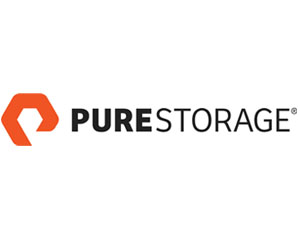As IT leaders prioritize cloud, mobile and edge computing solutions, modernizing data storage has become less of a priority. More than 80 percent of data stored in data centers today lives on legacy solutions such as magnetic hard disks. But Pure Storage’s flash-optimized system is unlocking hidden opportunities in data storage. It reduces energy consumption by up to 85 percent and data center energy by 20 percent, explains Kathy Mulvany, global head of environmental, social and governance efforts for Pure Storage.
This tech advancement has come just in time to help businesses manage their operational and transactional data. Too often, organizations find themselves running out of storage space or data center space, missing service-level agreements, or struggling to balance budgets as maintenance and energy costs climb.
With Pure Storage’s flash-optimized system, energy is already optimized. It uses two to five times less power and space than competitive solid-state drive systems and five to 10 times less power and space than hard disk systems. It’s also simplifying upgrade cycles, which can be disruptive and expensive, says Don Kirouac, technical lead of product sustainability in Pure Storage’s Office of the CTO.
Traditional storage solutions create e-waste, can disrupt application access for weeks or months, and impact business continuity. Evergreen storage architecture from Pure Storage offers an energy-efficient, flexible and future-ready alternative. Here’s what you need to know:
DISCOVER: Uncomplicate data storage forever with help from Pure Storage and CDW.
What Is Future-Ready Data Storage?
Future-ready data storage is always accessible, sustainable and easy to upgrade.
Traditional spinning hard disk drives provide storage capacity but often lack reliability, efficiency and flexibility because of their mechanical nature — moving parts, limited input/output per second (IOPS) per device and a higher power draw per IO are required to operate.
But moving parts can break, wear out or lose data if power is interrupted. Pure Storage’s flash-based solutions have no moving parts. They are also capable of multiple orders of magnitude greater IOPS per device, use far less energy per IO and weigh a fraction of comparable HDDs. Pure Storage’s solutions also have far greater storage density (usable terabytes per rack unit), as they require up to 90 percent less physical rack space than HDD-based solutions.
Click the banner below to learn how a modern data platform supports smart decision-making.
How Is Pure Storage Data Different?
Upgrading traditional storage architectures can be time-consuming, labor-intensive and disruptive to business. Even if the upgrades are minor, new controllers or storage shelves can require application downtime or a maintenance window (typically outside of normal working hours).
In some cases, just making incremental changes means taking all storage offline or taking a 50 percent performance reduction while groups of controllers are upgraded. In others, legacy tools simply aren’t compatible with the next generation of storage technologies.
In either case, upgrading from one array model or family to another without disruption is simply not possible with traditional storage architectures. This all leads to lost productivity, excess energy consumption, more e-waste, and resource- and budget-intensive efforts for IT.
LEARN MORE: Keep data secure in hybrid environments.
Pure Storage’s flash-based approach means that upgrading data storage is simple, streamlined and not disruptive for businesses. Nondisruptive upgrades across product generations and within product families have always been foundational for Pure Storage. Its products have an expected service life two to 2.5 times longer than traditional storage, reducing the number of hardware migrations and in turn dramatically reducing the amount of e-waste generated.
“You avoid full product replacements,” Mulvany says. “We can swap out storage controllers and give customers greater performance and functionality without disrupting operations.” And, since flash storage is far more reliable and resilient than traditional HDD-based solutions, IT teams don’t have to worry about small technical issues becoming big problems.
The Benefits of Direct Flash Technology
Moving to flash-based evergreen architecture offers multiple benefits for companies, including:
Reduced costs: Flash storage is more cost-effective and efficient than its HDD counterparts. “What makes our Evergreen storage solution unique is our DirectFlash technology,” Mulvany says. “DirectFlash is more performant, reliable and efficient than commodity HDD or SSD. This allows companies to reduce energy consumption, reduce the environmental impact associated with e-waste and reclaim data center floor space while storing more data.”
Reliable performance: Pure Storage’s co-engineered hardware and software interact with flash to minimize wear and tear while maximizing usable capacity, reliability and performance. Their technology and design result in a storage device that is six to 10 times more reliable than HDD-based solutions. In fact, 97 percent of all Pure Storage flash arrays sold are still in use today.
Customized usage plans: Pure Storage offers an optional Storage as a Service consumption model for flash storage. “Customers pay only for what they use when they use it,” Mulvany says. “They’re not overprovisioning and overbuying what they don’t need.” That allows customers to reduce their overall costs, energy consumption and e-waste — a win for resources and the environment.
This approach also gives companies access to rapid deployment and support. For example, the typical timeline for a new FlashArray install is four hours, and remote support and engineering teams are on standby 24/7 to identify and address potential problems.
57%
The percentage of surveyed CIOs who say they would replace half or more of their company’s technology stack if they could start from scratch
Source: cio.com, “The 12 biggest issues IT faces today,” June 12, 2023
A Future-Ready, Flexible Storage Solution
According to a recent survey, 57 percent of CIOs say that if they could start from scratch, they would replace half or more of their current technology stack to improve reliability and performance.
Future-ready, flexible storage helps make this possible. By investing in evergreen solutions that offer pay-for-use pricing, ongoing support and easy upgrades, businesses can build flash-based architectures that offer both immediate benefits and ongoing returns.
UP NEXT: Businesses are mining data with edge computing.
Brought to you by:














